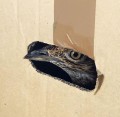 Species
Species 
Species
Little bustard Tetrax tetrax (Linnaeus, 1758)
Categories of protection
Directive Birds 79/409/EEC: Annex 1 Priority species
Bern Convention: Annex II
CITES: Appendix I
Legge 157/92: Especially Protected
Status of conservation
IUCN Red List: NT, Near Threatened
Red List of Italian Vertebrates: EN, endangered
Species of European Conservation Concern (Birdlife International 2004): SPEC 1, the species is
considered globally threatened
Species with a specific Action Plan: “European Union Action Plans for 8 Priority Birds Species –
Little bustard” (1997)
Although the Little bustard is a flagship species of the conservation of the steppe habitats and
the traditional ecosystems, its presence is decreasing all over the area. The Little bustard nests
in France, Spain, and Italy, where it nests especially in Sardinia and rarely in Apulia (province of
Foggia) in rural, not too anthropic areas, at altitudes between 0 and 500 meters. The species is
also present in the Balkans, in Eastern Europe, western Asia and North Africa.
It is sedentary and nesting in Sardinia; it was believed to be extinct in Sicily at the end of the 60s:
the last reporting was in 1977 in the province of Catania (Ciaccio and Priolo 1997). It regularly
nested in Molise until the 60s; the last report goes back to the beginning of the 70s. Once, it was
considered a common nesting bird, even if it was only located in Sardinia, Sicily, Abruzzo and
Molise, irregularly in the eastern Pianura Padana. The Sardinian population consisted of about
100-500 clutches or 1500-2000 specimens between 1958 and 1993 (Schenk 1995). In Apulia, the
presence of a population of 10-50 specimens is estimated, in the SPA object of the intervention,
(CSN 2006, Petretti 2007, Oss. Nat. Parco Nazionale del Gargano 2005-2009). These estimations
have to be checked since recent data of monitoring are lacking. At present, the species only nests
in Sardinia and Apulia (Pratesi 1976, 1978, Schulz 1980, 1981, 1985, Petretti 1985, 2007). The two
populations show a different trend. In the second half of the XIX century, there was a drop in the
Sardinian population, while the same trend reduced the population of more than 90% in Apulia.
The Apulian population is now located south of the Gargano Promontory, which represents the
center of the historic area of diffusion of the species along the Adriatic coast (Petretti 1985).
The species is linked to steppe environment vowed to pasture with asphodel and outcrop and to
mixed steppe environment with uncultivated grassland areas or hay meadows. In any case, its
survival depends on the preservation of a mosaic of areas with extensive pasture and cultivation
use. These habitats represent the anthropic version of the original Asian steppe, which was
the only habitat for the species before the development of agriculture. The dry herbaceous
ecosystems of lowlands and hills are often extensive pastures for ovine and other wild livestock,
and are still located in the central-southern Italy and in the major islands (Petretti, 1986a, 1991
e 1993). The steppe are considered among the most vulnerable and threatened environments in
Europe, due to the environmental transformation imposed by humans (Tucker & Evans 1997).
The species nests in hot, opened and dry environments, intended for pasture and extensive
agriculture; it prefers non-watered cereal leguminosae and fodder plants surfaces, and steppe-like
herbaceous dry and stony formations with a thin covering less than 20-40 cm high. The greatest
diffusion is registered up to 500 m a.s.l.. In Apulia, 100% of the lek are located in meadows-
pastures.
The reported information are taken from: Italian Ornithology Vol.2 Tetraonidae – Scolopacidae,
seen by Pierandrea Brichetti and Giancarlo Fracasso (2004) and the Volume “Important areas for
the avifauna in Italy” (Birdlife LIPU – Ministry of Agricultural and Forestry Politicies, 2000), seen by
Armando Gariboldi, Vincenzo Rizzi and Fabio Casale.

















.jpg)
.jpg)
.jpg)
.jpg)
.jpg)










































.jpg)
























